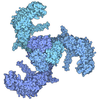[English] 日本語
 Yorodumi
Yorodumi- PDB-3j5r: Reconstruction of TRPV1 ion channel in complex with capsaicin by ... -
+ Open data
Open data
- Basic information
Basic information
| Entry | Database: PDB / ID: 3j5r | ||||||
|---|---|---|---|---|---|---|---|
| Title | Reconstruction of TRPV1 ion channel in complex with capsaicin by single particle cryo-microscopy | ||||||
 Components Components | Transient receptor potential cation channel subfamily V member 1 | ||||||
 Keywords Keywords | TRANSPORT PROTEIN / TRPV1 channel / capsaicin | ||||||
| Function / homology |  Function and homology information Function and homology informationresponse to capsazepine / negative regulation of establishment of blood-brain barrier / sensory perception of mechanical stimulus / peptide secretion / excitatory extracellular ligand-gated monoatomic ion channel activity / temperature-gated ion channel activity / cellular response to temperature stimulus / detection of chemical stimulus involved in sensory perception of pain / urinary bladder smooth muscle contraction / TRP channels ...response to capsazepine / negative regulation of establishment of blood-brain barrier / sensory perception of mechanical stimulus / peptide secretion / excitatory extracellular ligand-gated monoatomic ion channel activity / temperature-gated ion channel activity / cellular response to temperature stimulus / detection of chemical stimulus involved in sensory perception of pain / urinary bladder smooth muscle contraction / TRP channels / smooth muscle contraction involved in micturition / fever generation / thermoception / detection of temperature stimulus involved in thermoception / cellular response to acidic pH / response to pH / negative regulation of systemic arterial blood pressure / dendritic spine membrane / chloride channel regulator activity / glutamate secretion / monoatomic cation transmembrane transporter activity / negative regulation of heart rate / cellular response to ATP / ligand-gated monoatomic ion channel activity / response to pain / temperature homeostasis / cellular response to alkaloid / diet induced thermogenesis / cellular response to cytokine stimulus / intracellularly gated calcium channel activity / behavioral response to pain / detection of temperature stimulus involved in sensory perception of pain / negative regulation of mitochondrial membrane potential / calcium ion import across plasma membrane / monoatomic cation channel activity / extracellular ligand-gated monoatomic ion channel activity / sensory perception of pain / phosphatidylinositol binding / GABA-ergic synapse / phosphoprotein binding / microglial cell activation / cellular response to nerve growth factor stimulus / cellular response to growth factor stimulus / calcium ion transmembrane transport / calcium channel activity / lipid metabolic process / response to peptide hormone / calcium ion transport / positive regulation of nitric oxide biosynthetic process / transmembrane signaling receptor activity / sensory perception of taste / cellular response to tumor necrosis factor / cellular response to heat / response to heat / positive regulation of cytosolic calcium ion concentration / monoatomic ion transmembrane transport / protein homotetramerization / postsynaptic membrane / calmodulin binding / neuron projection / positive regulation of apoptotic process / external side of plasma membrane / neuronal cell body / dendrite / negative regulation of transcription by RNA polymerase II / ATP binding / metal ion binding / identical protein binding / membrane / plasma membrane Similarity search - Function | ||||||
| Biological species |  | ||||||
| Method | ELECTRON MICROSCOPY / single particle reconstruction / cryo EM / Resolution: 4.2 Å | ||||||
 Authors Authors | Liao, M. / Cao, E. / Julius, D. / Cheng, Y. | ||||||
 Citation Citation |  Journal: Nature / Year: 2013 Journal: Nature / Year: 2013Title: TRPV1 structures in distinct conformations reveal activation mechanisms. Authors: Erhu Cao / Maofu Liao / Yifan Cheng / David Julius /  Abstract: Transient receptor potential (TRP) channels are polymodal signal detectors that respond to a wide range of physical and chemical stimuli. Elucidating how these channels integrate and convert ...Transient receptor potential (TRP) channels are polymodal signal detectors that respond to a wide range of physical and chemical stimuli. Elucidating how these channels integrate and convert physiological signals into channel opening is essential to understanding how they regulate cell excitability under normal and pathophysiological conditions. Here we exploit pharmacological probes (a peptide toxin and small vanilloid agonists) to determine structures of two activated states of the capsaicin receptor, TRPV1. A domain (consisting of transmembrane segments 1-4) that moves during activation of voltage-gated channels remains stationary in TRPV1, highlighting differences in gating mechanisms for these structurally related channel superfamilies. TRPV1 opening is associated with major structural rearrangements in the outer pore, including the pore helix and selectivity filter, as well as pronounced dilation of a hydrophobic constriction at the lower gate, suggesting a dual gating mechanism. Allosteric coupling between upper and lower gates may account for rich physiological modulation exhibited by TRPV1 and other TRP channels. | ||||||
| History |
|
- Structure visualization
Structure visualization
| Movie |
 Movie viewer Movie viewer |
|---|---|
| Structure viewer | Molecule:  Molmil Molmil Jmol/JSmol Jmol/JSmol |
- Downloads & links
Downloads & links
- Download
Download
| PDBx/mmCIF format |  3j5r.cif.gz 3j5r.cif.gz | 405.9 KB | Display |  PDBx/mmCIF format PDBx/mmCIF format |
|---|---|---|---|---|
| PDB format |  pdb3j5r.ent.gz pdb3j5r.ent.gz | 320.9 KB | Display |  PDB format PDB format |
| PDBx/mmJSON format |  3j5r.json.gz 3j5r.json.gz | Tree view |  PDBx/mmJSON format PDBx/mmJSON format | |
| Others |  Other downloads Other downloads |
-Validation report
| Arichive directory |  https://data.pdbj.org/pub/pdb/validation_reports/j5/3j5r https://data.pdbj.org/pub/pdb/validation_reports/j5/3j5r ftp://data.pdbj.org/pub/pdb/validation_reports/j5/3j5r ftp://data.pdbj.org/pub/pdb/validation_reports/j5/3j5r | HTTPS FTP |
|---|
-Related structure data
| Related structure data |  5777MC  5776C  3j5qC M: map data used to model this data C: citing same article ( |
|---|---|
| Similar structure data |
- Links
Links
- Assembly
Assembly
| Deposited unit | 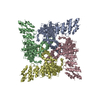
|
|---|---|
| 1 |
|
- Components
Components
| #1: Protein | Mass: 68242.156 Da / Num. of mol.: 4 / Fragment: SEE REMARK 999 Source method: isolated from a genetically manipulated source Source: (gene. exp.)   Homo sapiens (human) / References: UniProt: O35433 Homo sapiens (human) / References: UniProt: O35433Sequence details | THE TRPV1 CONSTRUCT COMPRISES RESIDUES 110-603 AND 627-764, WITH RESIDUES 604-626 DELETED. RESIDUES ...THE TRPV1 CONSTRUCT COMPRISES RESIDUES 110-603 AND 627-764, WITH RESIDUES 604-626 DELETED. RESIDUES 719-764 ARE NOT MODELED, WITH THE EXCEPTION OF 11 RESIDUES (NUMBERED 752-762 IN THE COORDINATE | |
|---|
-Experimental details
-Experiment
| Experiment | Method: ELECTRON MICROSCOPY |
|---|---|
| EM experiment | Aggregation state: PARTICLE / 3D reconstruction method: single particle reconstruction |
- Sample preparation
Sample preparation
| Component | Name: Rat TRPV1 in complex with capsaicin / Type: COMPLEX / Details: tetramer |
|---|---|
| Molecular weight | Value: 0.3 MDa / Experimental value: NO |
| Buffer solution | Name: 150 mM NaCl, 20 mM HEPES, 2 mM TCEP / pH: 7.4 / Details: 150 mM NaCl, 20 mM HEPES, 2 mM TCEP |
| Specimen | Conc.: 0.3 mg/ml / Embedding applied: NO / Shadowing applied: NO / Staining applied: NO / Vitrification applied: YES |
| Specimen support | Details: 400 mesh Quantifoil grid |
| Vitrification | Instrument: FEI VITROBOT MARK III / Cryogen name: ETHANE / Temp: 120 K / Humidity: 90 % Details: Blot for 6 seconds before plunging into liquid ethane (FEI VITROBOT MARK III) Method: Blot for 6 sec |
- Electron microscopy imaging
Electron microscopy imaging
| Experimental equipment | 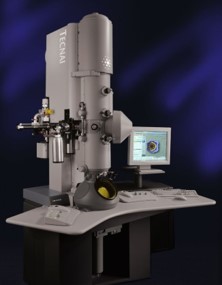 Model: Tecnai Polara / Image courtesy: FEI Company |
|---|---|
| Microscopy | Model: FEI POLARA 300 / Date: Jan 1, 2013 Details: Gatan K2 Summit operated in super-resolution counting mode, image recorded with dose fractionation method. |
| Electron gun | Electron source:  FIELD EMISSION GUN / Accelerating voltage: 300 kV / Illumination mode: FLOOD BEAM FIELD EMISSION GUN / Accelerating voltage: 300 kV / Illumination mode: FLOOD BEAM |
| Electron lens | Mode: BRIGHT FIELD / Nominal magnification: 31000 X / Calibrated magnification: 31000 X / Nominal defocus max: 3000 nm / Nominal defocus min: 1500 nm / Cs: 2 mm / Camera length: 0 mm |
| Specimen holder | Specimen holder model: OTHER / Specimen holder type: FEI Polara cartridge |
| Image recording | Electron dose: 21 e/Å2 / Film or detector model: GATAN K2 SUMMIT (4k x 4k) Details: Operated in super-resolution counting mode, dose fractionation |
| Image scans | Num. digital images: 900 |
| Radiation | Protocol: SINGLE WAVELENGTH / Monochromatic (M) / Laue (L): M / Scattering type: x-ray |
| Radiation wavelength | Relative weight: 1 |
- Processing
Processing
| EM software | Name: RELION / Category: 3D reconstruction | ||||||||||||
|---|---|---|---|---|---|---|---|---|---|---|---|---|---|
| CTF correction | Details: Each particle | ||||||||||||
| Symmetry | Point symmetry: C4 (4 fold cyclic) | ||||||||||||
| 3D reconstruction | Method: Maximum likelihood / Resolution: 4.2 Å / Resolution method: FSC 0.143 CUT-OFF / Num. of particles: 33238 / Nominal pixel size: 1.2156 Å / Actual pixel size: 1.2156 Å Details: The entire ankyrin structure was fitted as a single rigid body. As a result, the first two ankyrin repeats (UNP residues 111-199) are included but are not well defined by the experimental ...Details: The entire ankyrin structure was fitted as a single rigid body. As a result, the first two ankyrin repeats (UNP residues 111-199) are included but are not well defined by the experimental density. (Single particle details: 3D classification, refinement, and reconstruction were performed using RELION) (Single particle--Applied symmetry: C4) Refinement type: HALF-MAPS REFINED INDEPENDENTLY / Symmetry type: POINT | ||||||||||||
| Atomic model building | Protocol: AB INITIO MODEL / Space: REAL Details: REFINEMENT PROTOCOL--de novo model building DETAILS--The entire ankyrin structure was fitted as a single rigid body. As a result, the first two ankyrin repeats (UNP residues 111-199) are ...Details: REFINEMENT PROTOCOL--de novo model building DETAILS--The entire ankyrin structure was fitted as a single rigid body. As a result, the first two ankyrin repeats (UNP residues 111-199) are included but are not well defined by the experimental density. | ||||||||||||
| Refinement step | Cycle: LAST
|
 Movie
Movie Controller
Controller






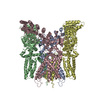


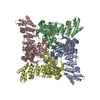
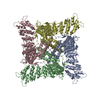
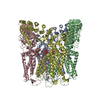


 PDBj
PDBj
